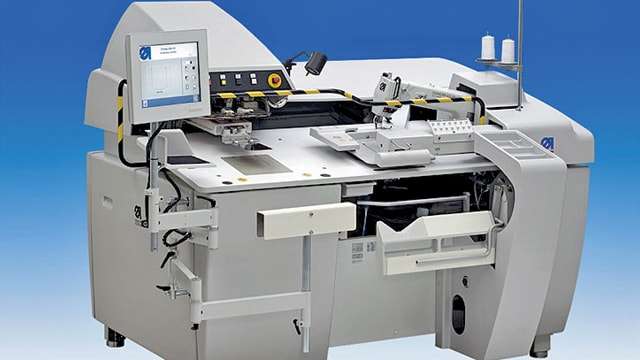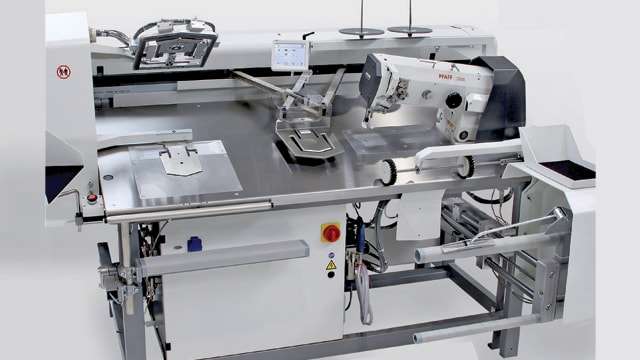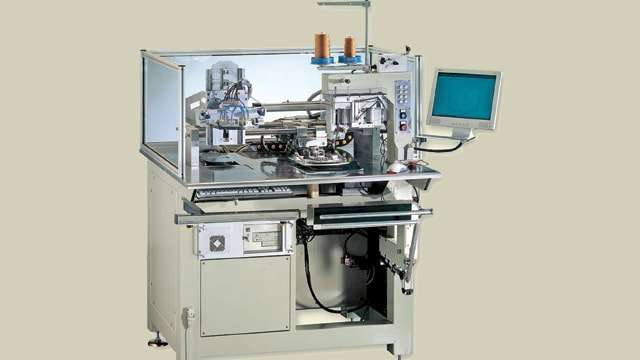
Commonly factories around the world use the cumbersome method of first pressing and creasing the pocket separately, and then marking the location point on the shirt fronts with a chalk/drill where the pocket has to be sewn, and finally they sew it using single needle lockstitch machine. The automatic shirt pocket setter today, creases the pocket, detects location of the pocket and sews it automatically. The operation has been able to bring together both creasing and positioning reducing frequency of loading and unloading and even transportation from one place to another which might spoil the crease of the pocket. The programming of the feeding process deskills the operation to such an extent that any semi-skilled operator can operate the machine to produce a perfect formal shirt.
Technology behind automatic pocket setter
A regular shirt pocket setting machine comes with single-needle direct-drive sewing machine head with servo motor, using high-capacity rotary hook and automatic thread trimming device, coupled with automatic edge folding station where edges of pocket are folded and creased. Automatic feeding is equipped with centre slider to transfer pieces to the sewing unit comprising of a sewing head, template with pattern plate to define the correct shape of the pocket and an automatic stack feeding device, which ensures that high-quality shirt fronts with correctly placed pockets are stacked for next operation.The automat has helped in combining series of pocket setting processes like the folding of a pocket, placement of the pocket on a garment body, sewing, back tacking and stacking in a single workstation, simplifying the entire process thereby increasing productivity as also achieving production without requiring the operator to have any special skill. So now, the patch pockets can be creased and attached with maximum efficiency, with changes and adaptations to pocket shapes like square, V-shaped, hexagonal rounded, stylized very easily and quickly according to the various subclasses. The automat also makes it possible to process striped and chequered fabrics as per pattern directly without any matching problems with correct view for precise aligning, while the sewing field size gives variety to different types of pockets which can be sewn flexibly along with seam corrections according to different fabrics.
Types of mechanism used
Stated below are the most exclusive features present in the machines which result in enhanced productivity, efficiency and quality consistency of the product.
Operating terminal acts as interface to import pocket seam programs.
Preset mechanism allows operator to place the shirt front and pocket on preset board for creasing while sewing machine is still engaged in sewing current garment pieces. Consequently, the operators can utilize this waiting time during operation to increase productivity.
Pocket mode selection along with pocket size folder for creasing helps in selecting various pockets to be sewn. This function is available in Duerkopp Adler 806-N-12101 and PFAFF 3588 which helps in selecting from range of pocket designs including symmetrical and asymmetrical pocket shapes.

Seam program and seam correction selection mode helps in identifying different pocket seam diagrams and seam allowance changes like single, double and decorative seams with seam contouring possible with options of creasing, corner and tack stitches available in Duerkopp Adler 806-N-12101. PFAFF 3588 even has functions to attach pocket with label, flap or pen slot attachments for adjustment, depending on pocket style.
Automatic vacuum system is used to fix the position of both shirt front and pocket component while creasing and sewing so that no pocket is positioned inappropriately, present in most of the automats which imparts iron free working. Besides, some automats like those of SewQ SGY-187-GB-6030 also possess air suction device which makes fabric smooth and provides much better stability for achieving highly-effective sewing.
Edge folding station, where creasing of pocket component takes place, comprises of pocket blank used for pressing pocket, edge folding frame for different size pockets and key panel which displays operating status.
Cloth edge sensor is a device for detecting material edge. Even if the operator fails to correctly position the pocket, the sensor present in the edge folding station detects the pocket placement position automatically on the shirt front. The automat by SewQ possesses edge folding station in combination with conveyor belt system in the sewing station, ensuring better fabric handling.
Marking light confirms vertical stripe patterns of the top-centre plait by assisting the operator with garment placement for accurate positioning of a vertically-striped garment body, thereby helping to improve the finished product quality and increase productivity. This is found in MAICA UAM01 for positioning of the pocket placement.

The transfer system is the system in which the transfer frame of the sewing unit moves to edge folding station and brings the creased pocket from edge folding station to sewing unit. Where the sewing head lowers and sews the pocket on the shirt front, the transfer system moves in X-Y directions as seen in PFAFF 3588, Duerkopp Adler 806-N-12101, Typical TC-764 , Jam International JT863 P and SewQ-187-GB-6030 which enables the sewing head to remain stationary while the transfer system has full flexibility of the sewing field size for sewing pockets of any size.
Sewing station
For sewing the pocket, different sewing heads are used comprising of the transfer frame and transfer plate for transferring the shirt-pocket components to the sewing head, keeping it in position while sewing. The sewing head of MAICA UAM-01 is movable up and down which enables the transfer system to remain stationary after bringing the shirt-pocket components, but the sewing field size for pocket sewing is limited in this case and is more suitable for regular pocket sizes.
Stacker is the mechanism by which the machines stacks the product after sewing the pocket. The same is made possible by out feed roller, clamp brackets and support, along with piece catcher in PFAFF 3588 which helps in efficient transfer of the shirt front. While Duerkopp Adler 806-N-12101 has feed roller and clamp bracket for shirt front displacement, SewQ SGY-187-GB-6030, Typical TC-764 and Jam International JT863 P have movable stacker with a clamp bracket to catch the piece.
PFAFF 3588 ensures changeover time of less than one minute (56 seconds precisely). Operator can change easily without any help of machine engineer.
Method of Working of a shirt pocket setting machine in an automatic shirt pocket setting machine, the operator is just required to set the automatic sequence on the preset board. The sequence of work is broken up station-wise as given below:
Edge folding station
The operator places the cut component of the shirt at the base of the station, over which the cut component of the pocket is set in a ‘pocket blank’ on the central slider. Above it, the edge folding frame fixes itself moving downwards pressing the pocket after folding, creasing by pressing pocket on the shirt panel, using the foot switch.
Sewing station
If everything is performed correctly at the edge folding station, the transfer frame of sewing unit moves to the edge folding station for taking the shirt-pocket components back to the sewing unit with the help of a transfer plate. The sewing head lowers and the fabric parts are sewn together automatically according to the preset function in some of the automats, while in others, the transfer system is movable while the sewing head is fixed for performing the operation.
Stacker
Finally the finished sewn product is deposited on the stationary stacker with the help of outfeed rollers, clamp brackets with a catcher and support from where the sewn component is removed.
The time taken to pick align and dispose a single shirt front with square pocket has been mentioned in Table 1.
|
Table 1: Total cycle time of different automat shirt pocket setters along with manual process time |
|
Machine name |
Machine serial No. |
Pick and align (in sec.) |
Combined process of creasing and sewing (in sec.) |
Dispose (in sec.) |
Total actual time taken (in sec.) |
Average single cycle time (in sec.) with allowance (20%) |
|
PFAFF |
3588-12/021 |
2 |
5 |
1 |
8 |
9.6 |
|
Jam International |
JT-863 P |
3 |
5.28 |
2 |
10.28 |
12.24 |
|
MAICA |
UAM01 |
4 |
6 |
2 |
12 |
14.4 |
|
Duerkopp Adler |
806-N-12101 |
4.8 |
5.2 |
2 |
12 |
14.4 |
|
Typical |
TC-764) |
5 |
7 |
2 |
14 |
16.8 |
|
SewQ |
SGY-187-GB-6030 |
4 |
8 |
3 |
16 |
19.2 |
|
Manual operation time (folding and sewing with SNLS machine) |
55 |
66 |
|
The above analyses was done based on the videos avalaible in the YouTube and few submitted by the companies. |
Benefits of installing shirt pocket setting machine
The automatic shirt pocket setting machine offers a gamut of advantages such as efficient combination of two operations with optional style kits to set pockets and attach flaps in one operation with the help of intermittent material feed which helps in reducing hook wear & tear to minimum. Individual seam programming and exact seam correction for different materials guarantee a high sewing reliability and consistent quality and also result in manpower reduction for doing the same operation. A fixed “zero point” on the machine for setting the shirt front and pocket makes it possible to do different style kits without time consuming re-adjustments. The percentage improvement in average cycle time along with hourly production capacity of machines of different brands have been described
|
Table 2: Improvement in automatic shirt pocket setter with respect to common process of pocket attaching |
|
Machine name |
Machine serial No. |
Average production/hr. for single pocket shirts |
Improvement |
|
in production |
|
PFAFF |
3588-12/021 |
375 |
6.94 times |
|
Jam International |
JT-863P |
294 |
5.49 times |
|
MAICA |
UAM01 |
250 |
4.62 times |
|
Duerkopp Adler |
806-N-12101 |
250 |
4.62 times |
|
Typical |
TC-764 |
214 |
3.96 times |
|
SewQ |
SGY-187-GB-6030 |
187 |
3.47 times |
|
Snls+manual folding |
54 |
Conclusion
Unlike jeans back pocket setter, shirt pocket attaching is not commonly used in the industry, although lightweight fabric and plaid and stripe matching pose additional challenges on the shopfloor. Several brands had to discontinue their model due to non-acceptance of the technology among shirt manufacturers. While some of the brands like Duerkopp Adler, PFAFF, JAM International offer exclusive model for shirt pocket attaching only, other brands like Typical, MAICA, SewQ offer flexibility in changing the die & clamp to use the same model for pocket setting in jeans or shirt front. Earlier the die & clamp changeover process was very cumbersome and required machine engineer’s intervention, resulting in high machine downtime. Now almost all brands offer easy & quick changeover, an additional reason behind growing acceptance of the technology, which also depends on fabric type and prior testing with actual specifications.

Leave a Reply